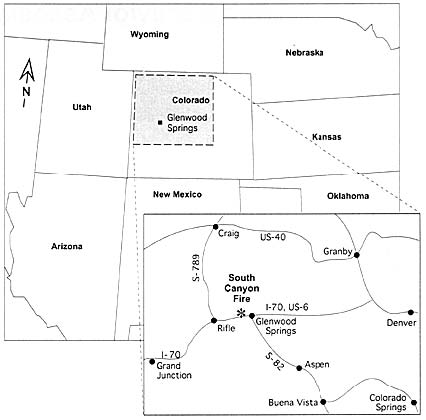
 South
Canyon Fire South
Canyon Fire
1994
6 Minutes for Safety — 2009
Fire Behavior Report, 1998
Fire Environment
- July 2 to
Evening of July 5
- July
5, 2230 to July 6, 1530
- July 6, 1530
to 1600
- July 6, 1600
to 1603
- July
6, 1603 to 1609
- July 6, 1609
to 1610
- July 6, 1610
to 1611
- July 6, 1611
to 1614
- July 6, 1614
to 1623
- July
6, 1622 to 1830
- July
6, 1830 to July 11
References
Appendix A
Appendix B
Appendix C
|
 Fire
Behavior Associated with the 1994 South Canyon Fire on Storm King Mountain,
Colorado Fire
Behavior Associated with the 1994 South Canyon Fire on Storm King Mountain,
Colorado
Introduction
Wildfires burned millions of acres in 1994 (Russo and Williams 1995).
A lightning strike to a ridge ignited one of those fires on July 2, 1994.
This fire, named the South Canyon Fire, occurred approximately 7 miles
west of Glenwood Springs, CO (fig. 1).
For the next 3 days the South Canyon Fire burned down the slopes in the
litter, debris, and grass covering the ground with occasional short duration
upslope runs and torching of individual or small groups of shrubs and
trees. By late morning on July 6 the fire covered approximately 127 acres.
At about 1520 (all times are mountain daylight saving time given in 24
hour format) a dry cold front passed over the area. At about 1600 and
for the next 4 hours the fire burned generally north and east through
the shrub and tree canopies as a fast moving wind-driven front. It exhibited
dramatically greater rates of spread, flame heights, and energy release
rates than at any time since its ignition.
The South Canyon Fire eventually burned 2,115 acres and was declared
controlled on July 11, 1994. This fire will not be remembered for the
acreage burned, but for the lives lost. On the afternoon of July 6, 1994,
fire entrapped and killed 14 firefighters, making the South Canyon Fire
one of the most tragic wildland fires to occur in the United States this
century.
Immediately following the accident an interagency team was formed to
conduct an official investigation into the causes of the fatalities. The
“Report of the South Canyon Fire Accident Investigation Team”
(USDA, USDI, and USDC 1994), hereafter referred to as South Canyon Report,
was released in August 1994. A followup report, titled the “Report
of the Interagency Management Review Team (South Canyon Fire)” was
released in October 1994 (IMRT 1994). This second report presented a corrective
action plan for improved firefighter safety based on findings from the
first report. A final report titled “Final Report of the Interagency
Management Review Team” was issued in June 1995 (IMRT 1995). This
report summarized accomplishments since release of the corrective action
plan and made further recommendations for improved firefighter safety.
The Occupational
Safety and Health Administration also investigated the incident
and presented a report (OSHA 1995).

Figure 1—Overview of South Canyon Fire location (not to scale).
Time constraints limited the original accident investigative team from
studying the fire behavior in detail. This report presents a more detailed
picture, than has been presented previously, of the factors that led to
the dramatic change in fire behavior on July 6, 1994. Information and
data were gathered from many sources including investigation reports,
firefighter interviews, site visits, and related scientific literature.
The information presented in this document refines previous work by the
accident investigators.
Unfortunately, during most wildfires, there is little documented quantitative
information about the fire spread during times when the fire is most active.
Such was the case for the South Canyon Fire. Given the lack of quantitative
fire behavior data, we reconstructed the fire behavior from witness statements
and information about the vegetation, topography, and weather present
at the time of the fire. To accomplish this we first developed a detailed
chronology of firefighter locations and movement during the time of interest.
The chronological history for the afternoon of July 6, 1994, occupies
a significant portion of this report. We believe that this information
is necessary to understanding the fire behavior. Using the witness statements
about the location and behavior of the fire and the chronology, we were
able to develop a sequence of fire perimeters.
The behavior exhibited by the South Canyon Fire on July 6, 1994, was
extreme in terms of intensity; but it can also be termed normal for the
fuel, weather, and topographical conditions present at the time. Similar
alignments of influencing factors and the resulting fire behavior are
not uncommon.
We present a summary of the South Canyon Fire and some key factors that
influenced the fire behavior. We describe the topography, the vegetation
or fuel, and weather present during the fire. This is followed with a
chronological narrative of firefighter movements and fire perimeter locations
prior to and during the blowup and entrapments. Finally, key fire behavior
points are discussed and summarized. Our reconstruction of the fire behavior
is based on best estimates of fire spread rates, firefighter travel times,
and witness statements. When specific statements or information from witnesses
are used, we cite the source.
We frequently use the terms “intensity” and “blowup.”
In the general sense, “intensity” implies the size of the
flames, the fire’s spread rate, and the rate of energy release from
the fire. “Blowup” indicates a rapid change from a low intensity
surface fire, to a high intensity fire burning through the whole vegetation
complex, surface to canopy, and demonstrating dramatically larger flame
heights, higher energy release rates, and faster rates of spread. We define
other terms used in this report in appendix A.
<<<
continue reading—Fire Behavior at South Canyon Fire, Overview >>>
|
